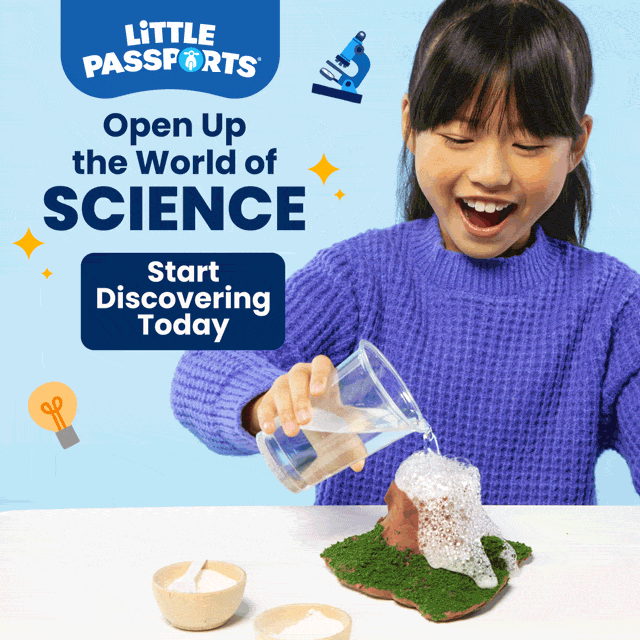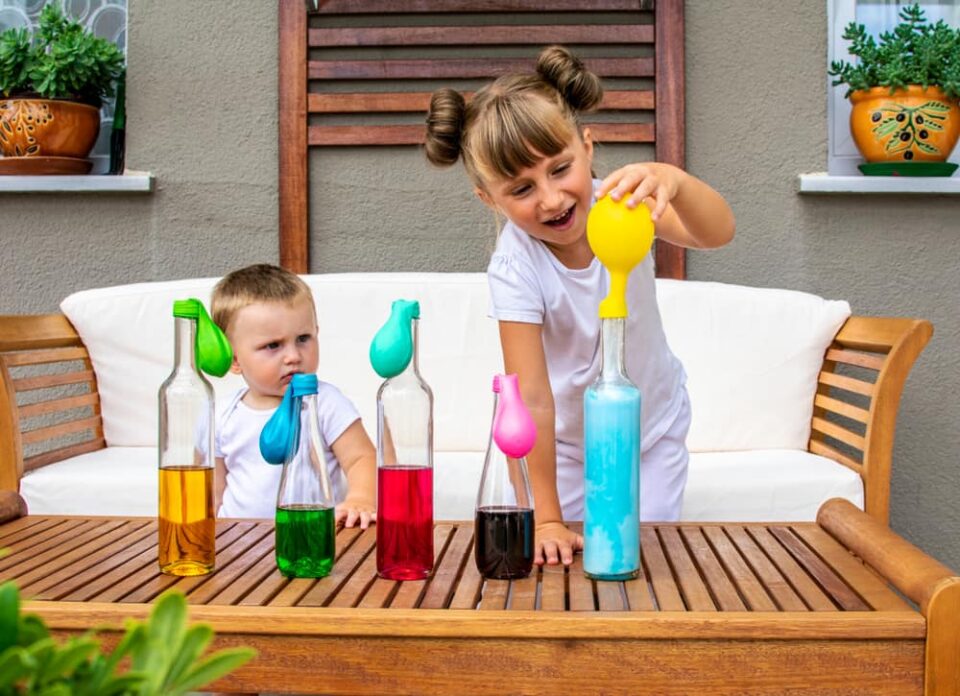
Learn about Reactions with This Vinegar and Baking Soda Experiment
Take a peek in your pantry. Do you have baking soda and vinegar? If so, you and your kids have the basic supplies for a bubbly science experiment!
These two products are staples in many households because they are essential cooking ingredients., Baking soda helps baked goods rise, and a pinch or two will balance the acidity in dishes like tomato soup. Vinegar is a common ingredient in salad dressings and sauces, and a splash will elevate any dish in need of a bright, tangy flavor.
But can you mix vinegar and baking soda together? You sure can—and the result is a wonderful at-home science experiment. Vinegar and baking soda create a very effective cleaner for dishwashers, washing machines, clogged sinks, and even tile grout because of the chemical reaction that occurs when the two substances interact. You can harness this same reaction for an exciting chemistry activity!

The Science behind the Reaction
A baking soda and vinegar reaction is simple and safe for budding scientists of all ages. Older children may be curious about why the reaction occurs—here’s the rundown:
When combined, baking soda and vinegar undergo an acid-base reaction. Acids and bases are aqueous solutions (meaning they’re substances dissolved in water) that exist at opposite ends of the pH (potential of hydrogen) scale, which spans from 0 to 14. Acids measure between 0 and 7 and bases measure between 7 and 14, while a pH of 7 indicates a neutral substance. In simple terms, bases have the potential to gain hydrogen ions (an ion is a type of atom, one of the tiny building blocks that make up all matter), while acids have the potential to donate hydrogen ions to another substance.
Baking soda, or sodium bicarbonate, has a pH level of 9, making it a base. Vinegar, which is acetic acid dissolved in water, has a pH level of 2–3, making it an acid., Baking soda is made up of sodium, hydrogen, carbon, and oxygen atoms. Vinegar is made up of hydrogen, carbon, and oxygen atoms.
When you mix baking soda and vinegar together, two hydrogen atoms move from the vinegar to the baking soda to create a salt called sodium acetate. The remaining atoms create a new acid—but it breaks down quickly into water and carbon dioxide gas.

It’s Time for an Experiment

Your kids can witness an acid-base chemical reaction right in your kitchen. This baking soda experiment for kids combines vinegar and baking soda, then uses the resulting carbon dioxide gas to inflate a balloon. This same reaction is behind science projects like fizzy potions and DIY volcanoes.
Children of all ages can participate in every step of this experiment, but younger kids may need help from an adult. You know your kid scientists’ abilities best!
Vinegar and Baking Soda Experiment
Materials
- ⅓ cup baking soda
- 1 cup white vinegar
- 1 empty plastic water or soda bottle
- 1 uninflated balloon
- 1 funnel
Directions
- Use the funnel to fill the uninflated balloon with baking soda. Kids can help pour the baking soda while an adult holds the funnel and balloon.
- Pour the vinegar into the empty plastic bottle. Fit the opening of the balloon over the mouth of the bottle, trying not to spill any baking soda out of the balloon.
- Once the balloon is securely attached to the bottle with no gaps for air to escape, lift the balloon and let the baking soda fall into the vinegar below.
- Watch as the baking soda and vinegar react—the mixture will bubble and fizz. As the reaction takes place, the balloon should begin to expand and fill with carbon dioxide gas!

Using the Scientific Method
The balloon experiment is an excellent way to show your children the wonders of chemistry from the comfort of home. You can build on their learning by teaching them to follow the scientific method. This process is what scientists around the world use to construct and test their hypotheses (what they think will happen in an experiment).
Help your children navigate the following steps:
- Identify a problem or question: Ask your kids, “What do you think will happen to the balloon when we combine vinegar and baking soda?”
- Form a hypothesis: Encourage your children to guess how the vinegar and baking soda will react—and how that reaction will affect the balloon. Help them frame their hypothesis using the “if _____, then _____” format. For example: If the baking soda and vinegar mix, then bubbles will form and the balloon will expand.
- Conduct the experiment: Follow the steps in the experiment above to test their hypotheses.
- Collect and analyze the results: Help your kids monitor how the experiment plays out. Older children can make notes, while young ones may want to take photos or draw pictures of the experiment.
- Provide a conclusion: Ask your kids if their hypotheses were correct. If they were, great! If not, ask them how the experiment differed from what they expected. Remember: Science is all about making wrong guesses and learning from them. Help your young chemists understand that an incorrect hypothesis is just as good as a correct one.
You and your kids can apply the scientific method to all kinds of at-home science experiments. There are plenty of family-friendly activities to grow your children’s interest in chemistry. For example, you could test whether a substance is acidic or basic using cabbage and water, or using carbon dioxide gas to create a miniature “snowstorm.”
If your kids have a passion for experiments, sign them up for a science-based subscription box from Little Passports. The Science Junior box, designed for five-to-eight-year-olds, helps early elementary schoolers explore the wonders of science firsthand. Science Expeditions teaches children ages eight and up about more advanced scientific topics, such as aerodynamics and solar energy. Each month you’ll receive a box full of activities and discoveries to help your budding scientists flourish and grow.

